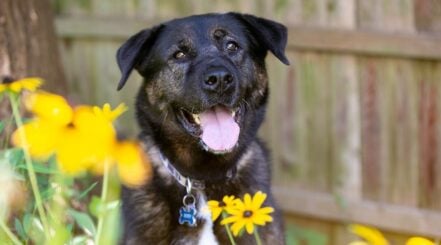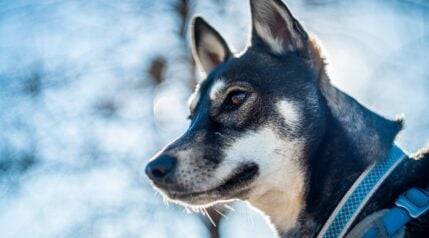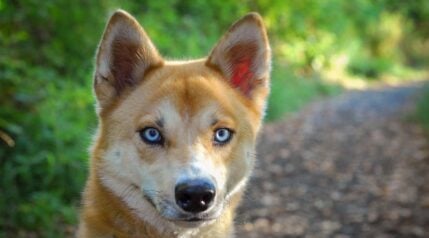Considering the Shiba Inu vs. the Akita for your next furry friend? Both breeds can make excellent family dogs but have some significant differences, despite coming from the same country of origin.
The Shiba Inu and the Akita are often considered siblings outside their homeland in Japan, but they are their own distinct breeds. One breed is ancient, and the other is relatively new in comparison. And now, they are both becoming increasingly popular outside of Japan.
You might be wondering if their personalities are as similar as their looks. Or maybe you are curious about which one would make a better family pet for your family. Whatever your reason for being here, after reading this breed comparison guide, you’ll know everything you need to know about the Shiba Inu and Akita’s similarities and differences. So, let’s get started and say Konnichiwa to these beautiful Japanese canines.
Breed Comparison
Shiba Inu
- Height 13-17 Inches
- Weight 17-23 Pounds
- Temperament Alert, Active, Attentive
- Energy High
- Health Average
- Lifespan 13-16 Years
- Price $1,200 and Up
Akita
- Height 24-28 Inches
- Weight 70-130 Pounds
- Temperament Courageous, Dignified, Loyal
- Energy High
- Health Average
- Lifespan 10-13 Years
- Price $1,200 and Up
Key Differences
- The Akita is significantly larger. They weigh 70 to 130 pounds, while the Shiba Inu weighs 17 to 23 pounds. The Akita reaches 24 to 28 inches tall, while the much shorter Shiba stands 13 to 17 inches tall.
- The Shiba Inu lives longer, with a life expectancy of 13 to 16 years, while the Akita’s is 20 to 13 years.
- Akitas are heavy droolers, and Shiba Inu rarely drool.
- The Shiba Inu sheds much less.
- The Akita needs more room and cannot live in small spaces.
- Shiba Inus are more attention-seeking and have a headstrong streak.
Breed History
It is often asked if Akitas and Shibu Inus are the same, and the answer is no. They are two distinctly different breeds. Looking into the Shiba Inu and the Akita’s pasts will not only help you to understand more about their personality. But it will also teach you about their differences. A dog’s history will often tell you much about what you can expect from them as a family pet. It’s an incredibly important part of your doggy research.
Shiba Inu

The Shiba Inu is an ancient dog believed to originate from 300 B.C. Back then, he was used for flushing birds and other games for his master. The larger Shiba were also used for hunting wild boar, earning his keep by bringing food to the table. They are the smallest of the six original Spitz-type dogs.
He was never seen outside of Japan until the 1950s. Our love affair with the breed began when an American military family brought one back to America. The Shiba Inu is to the Japanese what the Labrador is to Americans – their most popular family dog. Additionally, they are an increasingly popular breed to mix with.
Akita

The Akita was developed in the 17th century and is the largest of the Spitz-type dogs. His creator, a banished aristocrat, spent his days on a northern Japanese island, creating a large and versatile hunting dog.
Over several decades the Akita was developed. He was powerful enough to hunt wild boar, deer, and the fearsome Yezo bear. Some families in Japan still use him for this purpose. Because of their nature, they are sometimes considered more dangerous than they actually are.
The Akita were only allowed to be kept by imperial families and their court. This law ended, and since then, he has been employed by families worldwide as the family protector and cuddly companion. They are a favored choice as a mixed breed as well, becoming popular among the designer dog world.
He is described as the most loyal dog breed, and this was highlighted by a famous Akita named Hachiko. He waited every day for nine years for his owner to return. Akitas are popular guardian breeds, often drawing comparisons to Pitbulls and other dogs with guardian instincts.
Appearance

The Shiba Inu and the Akita are similar in appearance, mainly because they are both Spitz-type dogs. They have similar features, with a foxy-shaped head and pointy triangle ears. Along with their deep chest and curly Catherine-wheel tails. Even though they both come from the Spitz family, the Shiba Inu and the Akita are sometimes compared to the Siberian Husky due to their wolfy looks.
The most obvious difference between them is their size. The Shiba Inu is a small-sized dog, versus the Akita, which is a large to a giant-sized dog. And it is this size difference that is the deciding factor between the two breeds. The Akita must have lots and lots of room and is unsuitable for apartment life. Whereas the Shiba Inu could happily live in an apartment.
They both have a thick and dense double coat that keeps them warm in the winter and resists water. The Shiba Inu has four coat color options: black and tan, cream, red, and red sesame. The Akita has many more coat colors, including brindle, black, red, fawn, and silver, with a black and white facial mask.
All Shiba Inu’s look the same. Compared to the Akita, who has two distinct looks. Some countries call one appearance the American Akita and the other the Japanese Akita. The Japanese Akita is more similar in appearance to the Shiba and looks like his big brother. The American Akita is squarer in appearance and looks a lot thicker and stockier.
Temperament

The Shiba Inu and the Akita are both similar and different in their personalities. They are both livewires and lots of fun. If you are looking for a gorgeous fluffy dog to keep your family entertained, they are both up to the job. They are both silly and goofy and aren’t afraid to get down and dirty.
They are also both suspicious and aloof of strangers. And they will alert you whenever there is someone at your gate. The Shiba Inu is more of a watchdog compared to the Akita, who is also a guard dog. Akitas are very protective of their family, and they are more dominant dogs.
They are both stubborn too, and they are quick to make up their own mind. This is another reason they should both be adopted by owners who know how to deal with independent dogs. They are both strong-willed and need an equally strong-willed master.
Another big difference between the two breeds is that one is more sensitive than the other. And you may be surprised to learn that it is the big burly guy that is sensitive. The Akita hates to be left alone and can develop separation anxiety, whereas the Shiba Inu is more independent.
When you do spend time with them, you’ll quickly learn that they are both snuggle bugs and they are very affectionate with their family. They love to spend time on the sofa with their loved ones, and they both make fantastic canine hot water bottles. You’ll just need a bigger sofa for the Akita, compared to the Shiba, who will happily squeeze himself onto your lap.
Sometimes owners want to have both breeds and wonder if Shibas get along with Akitas. Most of the time, they do, but this always depends on the specific environment and individual dogs.
Exercise

Another surprising fact is that they both require the same amount of exercise. Both Shibas and Akitas require 60 minutes of exercise every day, and they have lots of pent-up energy that they need to burn. If you cannot meet their exercise needs, they will both become destructive and problematic.
They are both highly intelligent dogs, meaning they need more stimulation than just a walk around the block to keep them invigorated. Try to mix up their activities. Otherwise, they will quickly become bored. They will both join you for any physical activities, and both breeds have excellent endurance.
As a pup, because the Akita is a giant breed, we would advise against any strenuous activities that will impact his joints as he develops. If you are looking for a jogging partner, you must wait until he is 12 months old. The Shiba, however, can start after six months or so.
They both need to be kept on a leash because of their high prey drive. And you can be sure that neither will take mercy on a squirrel or your neighbor’s cat. Being a giant and muscular dog, the Akita should be leash trained at an early age to ensure that he is manageable for you during walkies.
When it comes to doggy parks, if the Shiba Inu is socialized well, there shouldn’t be any issues with him socializing with other dogs. The Akita, however, might be agitated by other dogs, even if he is socialized well. This is specific to each Akita, so be sure to introduce them to other dogs early in life.
Training

Both breeds are headstrong dogs that need strong masters to show them the way. If you are a meek and mild dog owner, these dogs are not your ideal dog breed. This can make training difficult.
On the one hand, the Akita is easier to train because he is loyal and eager to please his master. Compared to Shiba Inu, who is independent. The Shiba does things on his time schedule, not yours. But, the Akita is a dominant dog who might feel the need to challenge you as the pack leader. Whereas the Shiba isn’t overly dominant and happier to join the ranks. Either way, you need to be an experienced dog owner.
They both need early socialization to ensure that they grow up to be polite and pleasant dogs. This is especially true of the Akita. Because he can be very protective of his family, his socialization is a lifelong commitment ensuring he remembers always to be polite.
The most effective dog training technique to use is positive reinforcement training. Thankfully, they are both motivated by objects, praise, and food. So use all three to encourage them to join you in training sessions. For Shiba Inu, keep his training sessions short and fun to prevent him from becoming bored.
Health

The Shiba Inu lives a little longer than the Akita, but that is simply to do with his size rather than his health. For a giant dog breed, a 10 to 13-year lifespan is very healthy. If you seek a giant dog breed to be around for a long time, the Akita has one of the longest.
They are both prone to hip dysplasia, an abnormal formation of the hip joint that can cause mobility issues. They both suffer from various eye conditions, with multifocal retinal dysplasia and cataracts being the most common concerns. The Shiba Inu is also prone to patellar luxation, which is an abnormal formation of the kneecap. And the Akita is prone to hypothyroidism, which is an underactive thyroid.
Nutrition

The Shiba Inu eats less than the Akita, and as such, the Shiba’s monthly food bill will be much lower. This is something that you need to consider if you are taking on the Akita. The Shiba Inu will eat around two cups a day, compared to the Akita, who will consume approximately four cups. Always feed your pup the best quality food that you can afford. High-quality kibbles will provide a well-balanced diet that meets all their nutritional needs.
The Akita should eat dog food formulas designed for large or giant breed dogs. This is especially important during puppyhood, as it will help to control his rapid bone growth. The Akita is also prone to a condition called bloat. It is a life-threatening condition that you need to make yourself aware of. Never feed him immediately before or after exercise.
Grooming

Both breeds have double coats, and they both shed moderately throughout the year. They also both shed profusely during the shedding seasons. With his larger body, the Akita’s shedding is much more noticeable than the Shiba’s.
Both the Shiba Inu and the Akita require brushing two to three times a week throughout the year. To keep control of their shedding during the shedding seasons, you should brush them most days. They both need to bathe once every 8 to 12 weeks and be sure to use a conditioner that will keep their coats feeling soft and lush.
Puppy Prices

The Shiba Inu and the Akita find themselves in the top 50 dog breeds. So they aren’t rare, but they aren’t common either. To find a reputable breeder, you may have to travel to find one. But trust us when we say it will be worth it when you find your healthy pup. The price for both of these guys starts at around $1,200.
Final Thoughts
The Shiba Inu and the Akita are both wonderful dogs who would make fantastic family pets. They are quite similar, but their differences mean that they need different types of family and home environments. If you consider welcoming one of these guys into your life, just be sure you can meet their needs. If you can, you can be confident that you will have many happy years to come with either of these gorgeous Japanese dog breeds.






I have 2 yrs old Akita and my boyfriend has 4 years old Shiba Inu, I recently moved to his house. My dog is more aggressive but his dog is more stubborn. Introducing them together was quite challenging but after 3 days, they seemed to bond well. PATIENCE is very important in raising these kind of breeds. Thank you for your article.
Had DNA done on my boy and shows 100% Akita of Asian/oceanic decent. Parents,grandparents and all sets of great grandparents all 100% akita. The Average Diversity has him on the 31 scale. But what would his lineage be? I don’t see where I can attach photos. He has some mask shading but isn’t huge like American Akitas. Very light coloring in fawn. I’m curious to what he is.
I saw that no one has commented so I wanted to say that I appreciated this article immensely. You’re doing Dog’s work. xD